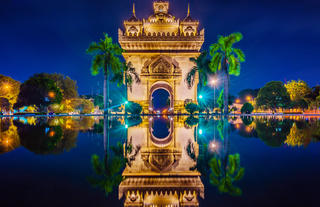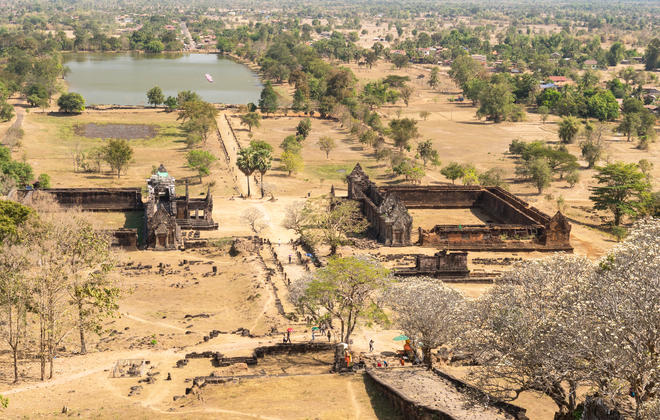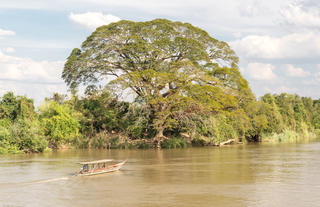Wedged between a number of larger neighbouring countries, Laos is often overlooked in favour of tourism giants such as Thailand and Vietnam. But these travellers are missing out on an extraordinarily scenic and culturally rich destination. Laos boasts a reputation as the least visited, least Westernised, and most untouched of all Indochinese nations. Only time will tell how long this will last, but while it does, visitors who choose to explore this nation’s remote areas will be richly rewarded. Laos’ primary drawcard is undoubtedly the mighty Mekong River which traverses the length of the country and is considered the second most biodiverse river in the world. In the north, the landscape is characterised by little-explored jungle-clad mountainous areas where visitors can witness the intriguing cultures of the various hill tribes that populate this region. Travellers on the hunt for cultural interest should head for the bustling capital of Vientiane, with its innumerable temples and Buddhist monuments. It is this variety of exotic wildlife, remote wilderness and remarkable cultural treasures that make Laos a truly unique and unforgettable holiday destination.
ViVientiane, the capital and largest city of Laos, offers a refreshing contrast to many Southeast Asian capitals—uncrowded, unhurried and imbued with a gentle, understated elegance. Set along the Mekong River, the city blends leafy boulevards, serene temples and evocative French-era architecture with a relaxed riverside lifestyle. Its spiritual heart is Pha That Luang, the nation’s most revered monument, a radiant 16th-century golden stupa symbolising Lao identity and Buddhist devotion. Travellers can wander between pavement cafés, atmospheric night markets and riverside restaurants, all of which reflect the city’s famously tranquil rhythm. Cultural highlights include the Laos National Museum, where thoughtfully curated exhibits trace the country’s long and complex history. With its calm disposition, historic charm and warm hospitality, Vientiane offers a captivating introduction to the soul of Laos.





Wedged between a number of larger neighbouring countries, Laos is often overlooked in favour of tourism giants such as Thailand and Vietnam. But these travellers are missing out on an extraordinarily scenic and culturally rich destination. Laos boasts a reputation as the least visited, least Westernised, and most untouched of all Indochinese nations. Only time will tell how long this will last, but while it does, visitors who choose to explore this nation’s remote areas will be richly rewarded. Laos’ primary drawcard is undoubtedly the mighty Mekong River which traverses the length of the country and is considered the second most biodiverse river in the world. In the north, the landscape is characterised by little-explored jungle-clad mountainous areas where visitors can witness the intriguing cultures of the various hill tribes that populate this region. Travellers on the hunt for cultural interest should head for the bustling capital of Vientiane, with its innumerable temples and Buddhist monuments. It is this variety of exotic wildlife, remote wilderness and remarkable cultural treasures that make Laos a truly unique and unforgettable holiday destination.





Serene and unpretentious, Thakhek rests along the Mekong River opposite the Thai town of Nakhon Phanom and serves as the ideal launching point for one of Laos’s great natural wonders: the spectacular Konglor Cave. Set within the Phou Hin Bun National Biodiversity Conservation Area, this immense limestone cavern winds for nearly 8 kilometres through the mountains, soaring up to 50 metres high in places and revealing extraordinary displays of stalactites and stalagmites. Visitors enter by boat along the Hin Bun River, which flows through the entire length of the cave—an otherworldly journey through cool darkness and cathedral-like chambers. Beyond Konglor itself, the surrounding national park offers its own allure, cloaked in ancient rainforest and dotted with dramatic karst formations, glittering pools and hidden lakes. Quiet, scenic and full of natural marvels, Thakhek is a rewarding base for exploring one of central Laos’s most remarkable landscapes.





Once a commanding power in the Mekong River basin, Champasak has evolved into a tranquil province best known for its serene landscapes, ancient heritage and the beguiling Si Phan Don (4,000 Islands) archipelago. Its namesake town, Champasak, is a peaceful riverside settlement graced with French colonial buildings, shimmering Buddhist temples and a slow, timeless rhythm. The province’s crown jewel is Wat Phu, an evocative pre-Angkorian Khmer temple complex and UNESCO World Heritage Site dating back to at least the 5th century. A fragrant frangipani-lined stone stairway leads to its upper sanctuary, rewarding visitors with sweeping views over the surrounding plains and the remnants of this ancient spiritual centre. Beyond its archaeology, Champasak is a paradise for adventure seekers and nature lovers alike, with 178 named mountains, vast protected areas and riverine landscapes offering endless opportunities for exploration.





Don Khong (Khong Island), the largest island in the Mekong River’s Si Phan Don archipelago, offers an atmosphere even calmer than its famously tranquil neighbours, Don Khon and Don Det. Life here moves at a soothing, unhurried pace. Most activity revolves around Muang Khong, the island’s main town, while Muang Saen on the western shore is beloved for its spectacular sunset views across the river. A network of cycling and walking trails weaves through Don Khong’s landscapes, leading travellers past welcoming villages, serene temples, glowing rice paddies and sweeping river vistas—making it an idyllic escape for those seeking quiet beauty and authentic Lao island life.











